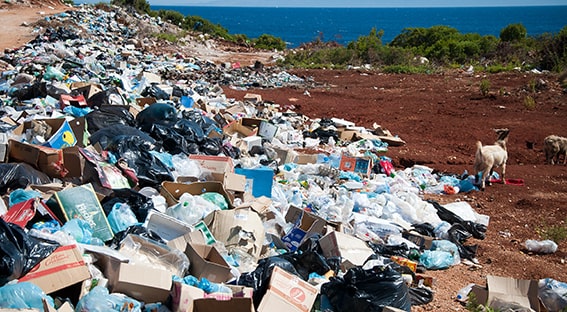The term "end of life" doesn't signify the end of its impact. In reality, particularly with plastic materials, their persistence and pollution continue long after their intended use. This clarifies that there's no true "end of life" for plastics and similar waste types. Depending on how waste is managed, it can pose a substantial threat to both the environment and the climate once it enters the waste phase of its life cycle. Plastic waste, in particular, doesn't truly degrade; instead, it breaks down into minuscule particles that are hardly discernible to the naked eye – these are referred to as 'microplastics'. These microplastics are hard to identify and nearly impossible to entirely eliminate from the environment.
Although the incineration of plastic is often termed "energy recovery", the reality is that burning waste emits greenhouse gases, primarily CO2. Moreover, waste commonly contains additives that prove hazardous upon release into the environment during incineration – a longstanding concern.
Our client stands as a global leader in commercial microwave applications tailored for energy conversion technologies. They excel in transforming diverse feedstock such as biomass, plastic waste, scrap tires, and refinery residues into invaluable raw materials. At the heart of our client's systems, microwaves synergize with cutting-edge catalysts to yield high-quality bio oil, bio gas, and bio-activated carbon. These products serve not only as renewable energy sources but also as foundational materials for the future's advanced applications.
The by-products, oil, and gas, generated through the depolymerization process can undergo further refinement to achieve compliance with industry standards. The superior bio-oil and biogas produced find utility in energy generation and the petrochemical sector. Bio-activated carbon, which boasts exceptional quality and recyclability, already finds its footing in an array of industrial applications, encompassing gas and air purification.
The mounting concerns about the environment and heightened awareness have led to stringent emissions regulations. Consequently, industries have shifted their focus towards technology advancement and innovative applications of bio-activated carbon, particularly in domains like air treatment and cleansing. The role of bio-activated carbon extends notably to water treatment, spanning drinking water, industrial water, groundwater, and sewage.
Furthermore, our bio-activated carbon proves versatile, finding purpose in methane and hydrogen storage, solvent recovery, decaffeination, gold purification, metal extraction, medicinal applications, removal of radioactive radiation from water, teeth whitening, hydrogen chloride production, and a multitude of other uses. A striking example lies in Southeast Asia, where millions of tons of highly valuable yet underutilized waste biomass are annually incinerated by farmers. Leveraging this biomass beyond mere incineration reaps both substantial profits and environmental benefits.




Ammonium, though integral to the process, can detrimentally impact microflora structure and diminish the population of methane-forming microorganisms. Typically, the production process yields surplus ammonium hydroxide, commonly known as ammonia water or ammonia spirit, which necessitates subsequent filtration. However, our meticulously engineered bio-activated carbon, tailored for biogas plant operations, exhibits exceptionally fine pores and an extensive internal surface area, facilitating the absorption of substantial ammonium quantities. As a result, the efficiency of the system is greatly enhanced.
The mixture of fermentation cake and nutrient-enriched bio-activated carbon is then channeled into the production of organic NPK-fertilizer. This fertilizer acts as a comprehensive substitute for artificial NPK-fertilizers, contributing to a holistic and sustainable agricultural approach.
Achieve strong economic efficiency through the MWDP plant with a negative CO2 balance.
Attain low-energy, cost-effective production of organic NPK fertilizer.
Agricultural enterprises can reduce operational expenses regardless of global market conditions.
Agricultural businesses gain autonomy from global market pricing of synthetic NPK fertilizers, leading to a significant decrease in operational costs.

Antwerp Port House by Zaha Hadid Architects, Antwerp, Belgium
Protected by Copyright. Reprint or publication, also through electronic media, even in parts only after official approval in written. Some data is the property of the respective author.
This website, text and data provides general information. FSRE assumes no liability for the information given being complete or correct. Due to varying update cycles, statistics can display more up-to-date data than referenced in the text. Some data is the property of the respective author.
All product and company names are trademarks™ or registered® trademarks of their respective holders. Use of them does not imply any affiliation with or endorsement by them.